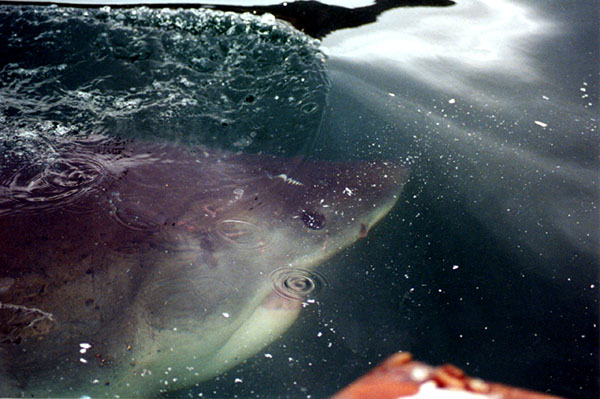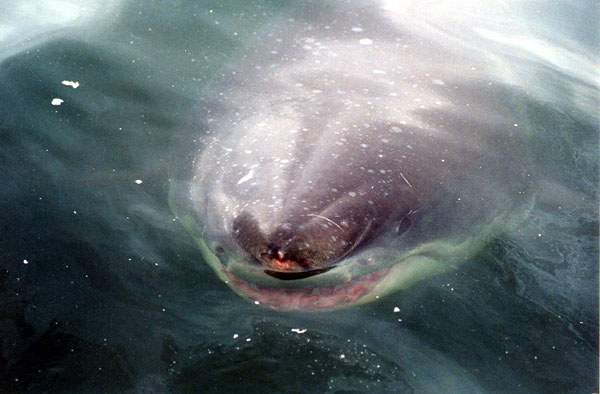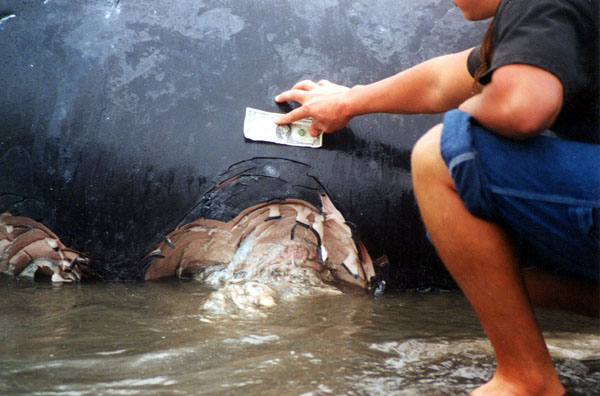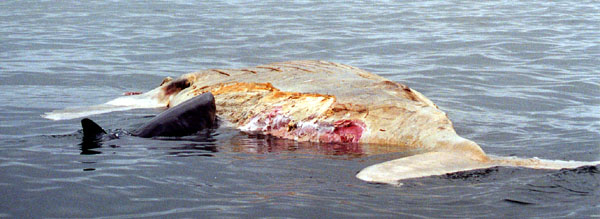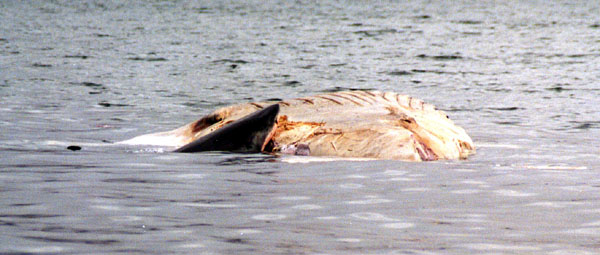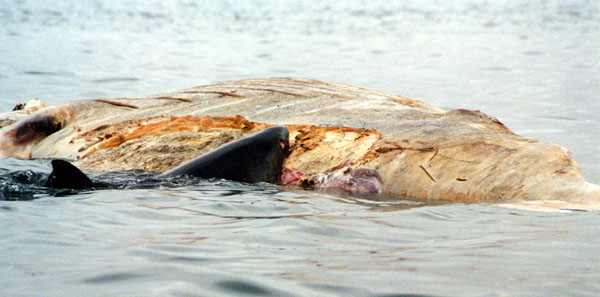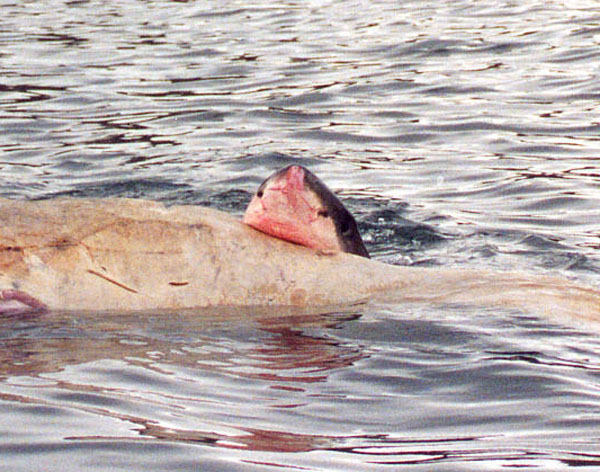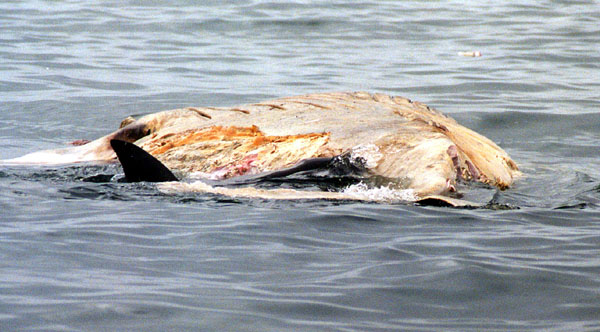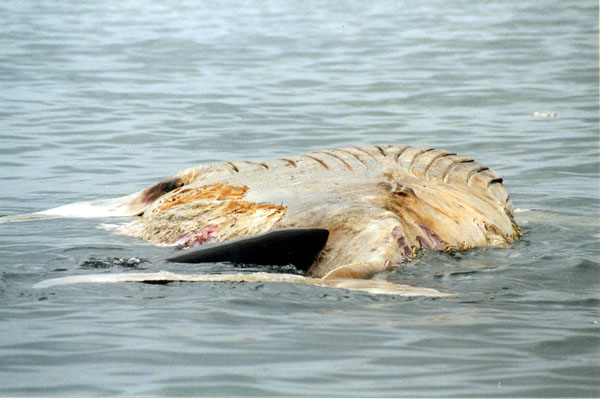A Firsthand Account of Three White Sharks Scavenging a Whale Carcass
9 October 2000, 2:30 p.m.
Point Reyes National Seashore, CA. Tobey Curtis, Karl Menard, and Karl Laroche, postgraduate lab assistants with shark behaviorist Dr. Peter Klimley of the University of California-Davis/Bodega Marine Laboratory, witnessed the scavenging event. They kindly share their observations with us.
White Shark Species ProfileThe Full Story
On 2 October 2000 a dead male humpback whale, approximately 25 to 30 feet in length, drifted in near shore, and beached at high tide. It appeared to have been hit by a large boat, and was still relatively fresh. A number of white sharks followed the whale as it drifted into very shallow water, and then departed after the whale hit a rocky reef in less than 10 feet of water. On this day, the sharks were observed from the bluffs overlooking the area. When the whale hit the beach, it was closely inspected and photographed by two of us (T.C. and K.L.) and staff of the Point Reyes National Seashore, including Research Director, Sarah Allen, and two rangers. A necropsy was to be planned for the following day, but the whale was pulled off the beach by that night’s high tide.
One week later, on 9 October, the whale was (serendipitously) still drifting in the shallows close to shore, and had not been disturbed by sharks for apparently some time. The three of us had just completed launching our research vessel, a 22-foot Panga, for the fall’s field work around Point Reyes, and we decided to inspect the decomposing whale from the water. The ebbing tide was carrying the carcass out into deeper water, away from shore for the first time since the whale had appeared. There was a slick of oils leaching from the whale that was visible on the surface at least a mile out to sea.
When the whale was over approximately 25 feet of water, the first shark appeared. In less than 15 minutes there were three sharks circling the whale and our boat. It seemed as though the sharks were circling in the slick, just waiting for the whale to drift out of the shallows, so they could feed. The sharks were distinguished as separate individuals by distinctive markings on their fins and body. One male, about 15 feet long, very actively inspected our boat, biting our propeller and bumping the hull with his snout, while the other sharks fed on the whale. He was easily distinguished by a deep wound on his back, just behind the dorsal fin. It is likely this wound was caused by a collision with a running boat.
The two other sharks, which appeared at almost exactly the same time, were about 12 feet long, and one was determined to be a female. These two individuals fed simultaneously at times, one on either side of the whale. This behavior has not been reported in the literature. In other reported cases when a number of feeding sharks were present, only one individual fed at a time.
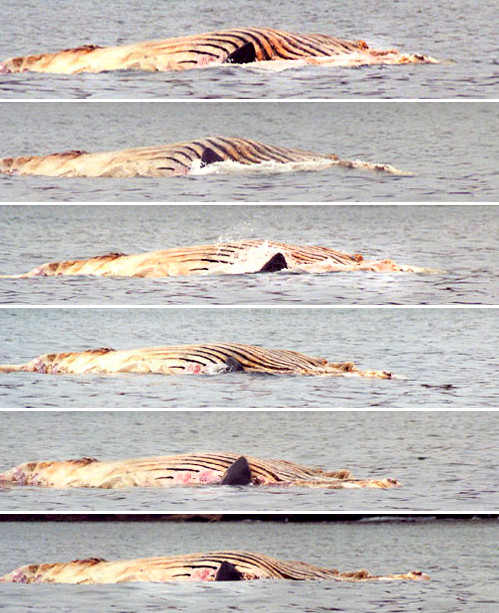
The sharks tended to feed actively in 5 to 10 minute bouts, and then there would be a hiatus for 10 to 30 minutes before they would feed again. Each of the sharks showed the same general method of feeding on the whale. They would first surface near the whale, line their body up with the targeted area, and within a thrust or two of their tail, be upon the whale. The sharks would rise high above the waterline, exposing their back, often down to the dorsal fin, and grab onto the whale with their jaws. We never witnessed any upper jaw protrusion, as is often seen when feeding on live prey. Their upper teeth anchored in the carcass, the sharks would then use their weight, and a side-to-side shaking motion of the head to remove large pieces of flesh. Sometimes they would roll on their side in order to get the needed leverage to remove their desired piece. The sharks were seen removing chunks of the whale’s blubber that were roughly between 10 and 20 pounds in a single bite.
We watched this spectacle for about 3 hours as the whale was continually pulled further out to sea by the ebbing tide. The sharks seemed to take turns feeding, and each fed for roughly equivalent amounts of time. When we left the scene, near dusk, the sharks were still actively feeding. Fishermen who observed the sharks later that night, counted 4 individuals feeding on the whale.
It is known that scavenging whale carcasses could comprise a significant portion of the white shark’s diet. Though it is a relatively rare event, the nutritional benefit received by the sharks is tremendous.
From observations like these we were able to conclude that white sharks behave differently while scavenging dead prey, than when hunting and attacking live prey, such as seals. These three sharks acted very deliberately and slowly while feeding. There was no observed competition between the sharks, and they all got a significant meal out of the whale; a meal that could possibly hold them for months. They seemed to be aware that their prey was not likely to get away, since they did not swim at high speeds or bite down swiftly, exposing their upper jaw. They were also appeared to be aware that the dead whale was not a threat to their safety, since we very rarely observed them rolling back their eyes for protection, as they often do with live prey.
This rare event provided insight into the ecology and behavior of white sharks in this region. We were very lucky to happen upon the scene, and witness these events at very close range.
–TC
